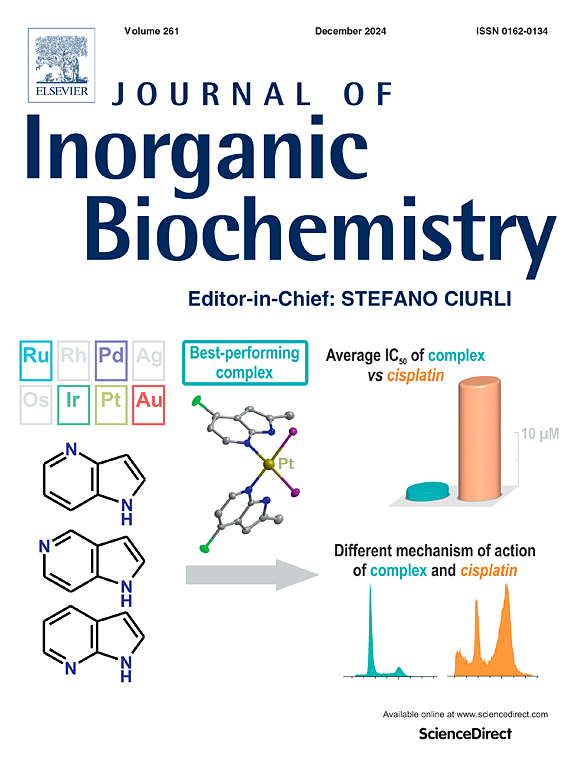VIM中活性位点邻近残基的突变间接决定了与d -卡托普利的相互作用并减弱了d -卡托普利的抑制作用
IF 3.2
2区 化学
Q2 BIOCHEMISTRY & MOLECULAR BIOLOGY
引用次数: 0
摘要
通过活性测定和x射线晶体学研究阐明了卡托普立体异构体对维罗纳整合子编码的金属β-内酰胺酶(特别是VIM-20、VIM-31和VIM-15)的抑制机制。在大肠杆菌中表达的三种VIM-2样变异体(VIM-20、VIM-31和VIM-15)和VIM-2均表现出稳态动力学参数相当的催化活性。在测试的硫醇类药物(L-和D-卡托普利,D,L-硫孤儿和2,3-二巯基醇)中,IC50分析表明,D-卡托普利和2,3-二巯基醇是本研究中检测的VIM酶的更有效抑制剂。值得注意的是,d -卡托普利对VIM-31的IC50值是一个例外,与l -卡托普利非常相似。为了阐明d -卡托普利的这种特殊抑制效力及其在VIM-31活性位点的结合模式,我们报道了VIM-20、VIM-31和VIM-15与L-和d -卡托普利配合物的高分辨率晶体结构。这些发现将有助于评估所鉴定的有效抑制剂d -卡托普利是否可以进一步开发为针对vim家族酶的pan抑制剂。本文章由计算机程序翻译,如有差异,请以英文原文为准。

Mutation of an active site-adjacent residue in VIM indirectly dictates interactions with and blunts inhibition by D-captopril
Activity assays and X-ray crystallographic studies were undertaken to elucidate the inhibitory mechanism of captopril stereoisomers on Verona integron-encoded metallo-β-lactamases, specifically VIM-20, VIM-31, and VIM-15. All three VIM-2-like variants (VIM-20, VIM-31, and VIM-15) and VIM-2 expressed in Escherichia coli exhibited catalytic activity with comparable steady-state kinetic parameters. Among the tested thiol drugs (L- and D-captopril, D,L-thiorphan, and 2,3-dimercaprol), IC50 analyses indicated that D-captopril and 2,3-dimercaprol were more potent inhibitors against the VIM enzymes examined in this study. Notably, the IC50 value of D-captopril against VIM-31 was an exception, closely resembling that of L-captopril. To elucidate this exceptional inhibitory potency of D-captopril and its binding mode in the active site of VIM-31, high-resolution crystal structures of VIM-20, VIM-31, and VIM-15 in complex with both L- and D-captopril are reported. These findings will help evaluate whether the identified potent inhibitor D-captopril could be further developed as a pan inhibitor targeting the VIM-family enzymes.
求助全文
通过发布文献求助,成功后即可免费获取论文全文。
去求助
来源期刊

Journal of Inorganic Biochemistry
生物-生化与分子生物学
CiteScore
7.00
自引率
10.30%
发文量
336
审稿时长
41 days
期刊介绍:
The Journal of Inorganic Biochemistry is an established international forum for research in all aspects of Biological Inorganic Chemistry. Original papers of a high scientific level are published in the form of Articles (full length papers), Short Communications, Focused Reviews and Bioinorganic Methods. Topics include: the chemistry, structure and function of metalloenzymes; the interaction of inorganic ions and molecules with proteins and nucleic acids; the synthesis and properties of coordination complexes of biological interest including both structural and functional model systems; the function of metal- containing systems in the regulation of gene expression; the role of metals in medicine; the application of spectroscopic methods to determine the structure of metallobiomolecules; the preparation and characterization of metal-based biomaterials; and related systems. The emphasis of the Journal is on the structure and mechanism of action of metallobiomolecules.
 求助内容:
求助内容: 应助结果提醒方式:
应助结果提醒方式:


